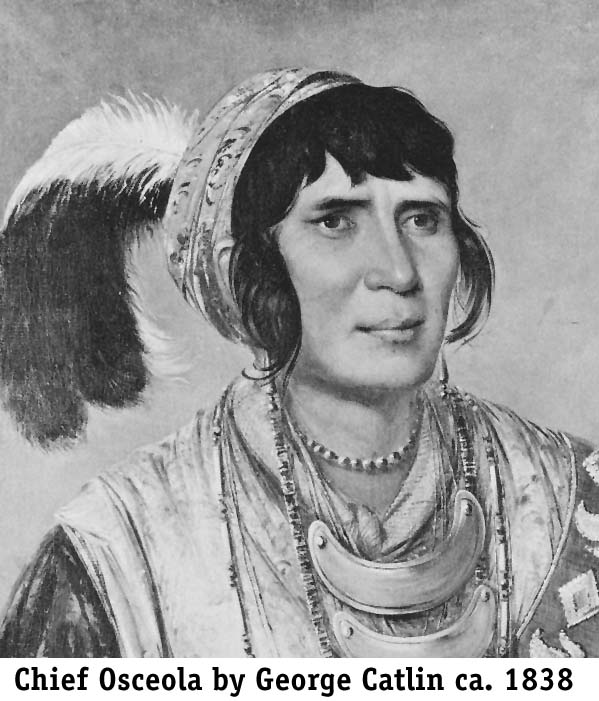PAGE 2 OF THE SEMINOLE INDIANS
As a foreword to the about to be Florida Wars,
treaties written in English will be made and broken by both sides. Unrealistic
Indian reservations will be established with little or no specific support
from either side. Trouble will brew everywhere. When it does, many career
army officers will not want to come to Florida, as it was not considered
career duty. The civilians will not like the military and vice-versa, but
both will agree - the Indians had to leave. The civilians will have to
be ordered not to sell liquor to the soldiers. The Seminoles will start
out organized, but this quickly disappears, however, the whites will remain
somewhat organized.
The Treaty of Moultrie Creek in 1823 shortly
after statehood created a reservation of four million acres in central
Florida south of Ocala, but the treaty did not satisfy either side. A drought
in 1827 forced the Indians outside of their Florida reservation boundaries.
At a conference on May 20, 1827, the Seminole Indians again rejected a
treaty to move west of the Mississippi River.
Then in 1829, Andrew Jackson was elected President,
and proposed to move all Indians west of the Mississippi. On May 28, 1830,
Congress passed the Indian Removal Act to do so. The Treaty of Fort Gibson
in 1833 specified that the Indians had three years to move to Oklahoma.
This lead to the separation of the Seminoles (The Trail of Tears) into
the Oklahoma and those who remained, the Florida Seminoles. Also in 1833,
Osceola emerged as an important Seminole leader.
There are many pros and cons about the effectiveness
of Osceola's leadership; at any rate, in June of 1835 there was an Indian-military
skirmish at Hickory Sink near Gainesville, Florida. Then in August, a military
courier named Private Dayton was killed near Fort Brooke (Tampa). Indian
Agent Wiley Thompson set December 1, 1835 as the final date for Seminole
Indians to sell their cattle before moving. Charlie Emathla (Tuko-see Mathla)
brought his cattle in and was ambushed while returning home. Osceola and
the Mikasuki were blamed for this act. Emathla's money and goods were left
to show that robbery was not the motive. 
It all came to a head on December 28, 1835,
with two events. First, Major Francis Dade, who had recently been transferred
from Key West, was en route with two companies from Fort Brooke (Tampa)
to Fort King (Ocala). They were ambushed near Bushnell, Florida and 108
soldiers were killed. Second, Indian Agent Thompson and others were killed
at Fort King as they strolled after dinner.
Two days later, General Clinch was attacked crossing
the Withlacoochee River. These and other incidents led to the Second Seminole
War (1835 - 1842).
The Second Seminole War was by far the most
significant of the three Seminole Wars. It must be remembered that the
Indian lands were constantly being taken from them, treaties made in a
language they could not read much less understand; then blatantly broken.
The principle difficulty at this time was the insistence that all Seminoles
be moved to the Oklahoma Territory Indian Reservation to live among their
life-long enemies in a completely alien environment. At this time, there
were still about 6,000 Seminoles in Florida. Those that remained became
the Florida Seminoles.
Closer to the Keys, on January 6, 1836, the
family of William Cooley was killed at their home on the New River (Fort
Lauderdale). Cooley himself was away from home at the time. As a result
of this hostile atmosphere, the Cape Florida lighthouse keeper John DuBose
took his family to Indian Key and then to Key West. Many other Keys families
also fled to Key West for protection. Indian Key, with six cannons, petitioned
for additional protection. When the petition fell through its inhabitants
decided to remain. Indian Key, Key Vaca and Key West were the principal
settlements in the Keys at this time.
On July 23, 1836, Cape Florida's assistant
lighthouse keeper Irwin Thompson and Aaron Carter, a Negro, were attacked
and driven into the lighthouse. The Indians set fire to the wooden door
and stairs, and Thompson and Carter climbed out onto the catwalk to survive.
Thompson threw a keg of gunpowder down the inside and almost extinguished
the fire. Carter was killed. Thompson was rescued by the crew of the ship
Motto and recovered in Key West.
A short time later, the Indians destroyed
the unattended garden of the Carysfort lightship keeper on Key Largo. They
then moved south to attack the schooner Mary near Tavernier. In 1837, they
shot and killed Captain John Whalton and one crewman of the Carysfort Lightship
when they came ashore for fuel wood.
Commodore Alexander Dallas, commander of the West
Indies Squadron, temporarily set up at Cape Florida until he could build
a fort on the mainland. The fort was named Fort Dallas. The army resented
a Fort being named after a naval officer. Lieutenant Colonel Harney and
his 2nd Dragoons also used the fort while pursuing Chief Chekika after
the Indian Key raid.
On April 24, 1838 Colonel Bankhead established
Fort Lauderdale on the New River. The same year the U.S. Revenue Cutter
Campbell established its headquarters on Tea Table Key just north of Indian
Key.
The Indians of south Florida had traded with the
Spanish from early times. Many spoke Spanish fluently. Part of the trading
was participating in the wrecking activities along the coasts. Because
of their association with Cuba, this group was sometimes referred to as
"Spanish Indians," and Chief Chekika was probably their last leader.
On July 23, 1839, Chief Chekika with about
160 warriors surprised Lt. Col. Harney's Dragoons on the Caloosahatchee
River. The Colonel and 14 soldiers escaped. This was probably the first
specific incident that was definitely ascribed to the "Spanish Indians."
Some of the earlier episodes could have been their doings also.
On August 7, 1840, Chekika led about 17 canoes loaded
with Indians on an attack of Indian Key. Dr. Perrine and six others were
killed and the island sacked, looted and burned. Lt. McLaughlin of Tea
Table Key had deployed his forces to Florida’s west coast, so only the
sick and a few caretakers remained on the Key for defense.
Col. Harney, who was then at Fort Dallas, gladly
accepted the assignment to hunt down Chekika, after barely escaping with
his life on the Caloosahatchee River. With 16 canoes, he surprised Chekika
in the Everglades and killed him.
Slowly, the Florida Seminoles were being severely
reduced as an effective force. One of their leaders, Osceola, had been
captured while under a flag of truce. Thirty-three other outstanding Florida
Seminoles, including Principal Chief Micanopy and Wild Cat, were tricked
and imprisoned the same way. Osceola died in prison in Fort Moultrie, South
Carolina.
The U.S. forces with about 5,000 troops continued
their efforts. By March of 1841, all of the citizen soldiers were dismissed
and on August 14, 1842, Col. Worth, in conferences at Fort King and Cedar
Key, announced the war was over. Until the Vietnam War, this was the U.S.’
s longest war. It too did not end in a decisive victory.
The total U.S. cost of the war is estimated
at $40 million and about 1,600 military deaths. The Florida Seminoles probably
never had more than 1,500 warriors. They were scattered about Florida with
most of those remaining being driven into the Everglades. Make no mistake,
the federals sent some of their most qualified to win the war. The list
includes "Old Rough and Ready" Zachary Taylor and "Old Fuss and Feathers"
Winfield Scott.
The brutality of war notwithstanding, there
were Florida's gains at the expense of Indian losses: considerable exploration
and mapping; many trails and roads established throughout; many forts that
served as starting points for towns; considerable amount of dollars spent.
The money was spent directly and indirectly through employment of civilians,
and payment for rent, food, supplies and relief. Another Florida benefit
of the Indian war was the Armed Occupation Act of 1842, which gave homestead
rights to white civilians.
Following the Second Seminole War there were
about 500 Florida Seminoles remaining. A two and one half million acre
“hunting and planting” preserve was established in the Lake Okeechobee
area. The principal chief was Billy Bowlegs and Sam Jones could be called
the second in command.
In 1849 there were two acts of violence on
the part of five Seminole renegades. This elicited quite a scare of another
Indian War, however it was settled by the Seminoles indicating their desire
for peace.
Then in December of 1855 a party of U.S. reconnaissance
surveyors were mapping the Seminole reserve in the Big Cypress. They came
across a Seminole farm and for some reason destroyed all the banana trees,
at least they were the ones blamed. Chief Billy Bowlegs retaliated by wounding
and killing several soldiers and the officer in charge.
This became known as the Third Seminole War
(1855 - 1858) whose center of action was mostly in the Fort Meade, Florida
and Big Cypress areas. The U.S. pressed about 1,500 soldiers (regular plus
militia) into service against the approximate 100 Seminole warriors. This
and others were more or less Vietnam type wars. Colonel Loomis declared
the war over on May 8, 1858. Billy Bowlegs and 163 others had been sent
west. Sam Jones remained hidden in the Everglades with about 200 men, women
and children. Both sides had about the same number of dead.
I know of no specific attacks in the Keys,
however as you can imagine, after the Second Seminole War fear of another
raid similar to Indian Key spread throughout the Keys. Dr. Joe Knetsch
of Tallahassee has been providing us with documentation of these concerns
and actions.
There is mention of a fourth Seminole War
(1880s), but it was not a war. The Florida Seminoles appeared to have just
disappeared into the Everglades from 1860 to 1880. A few came out to trade
and peace seemed to be at hand. In the 1880s a group of white men were
fired upon by an alleged band of Seminoles in the Everglades. United States
troops were dispatched from the West, but nothing much became of the incident.
By 1908, the Florida Seminole population was
given as 275. Since they were no longer a threat, broke and had little
land of value; the hate, greed and prejudice began to disappear. By an
act of Congress in June of 1924, all Indians were given citizenship status.
The Florida Seminole were divided into those who lived near Lake Okeechobee,
the Cow Creek division, and those who lived in the Big Cypress, Everglades
and Tamiami Trail, the Cypress division.
The Florida Seminoles were granted various
reservations such as the Hollywood, Brighton, Big Cypress and Mikasuki
on the Tamiami Trail. The Mikasuki officially became a separate tribe (as
they always were) by a federal law in 1962. The spelling was changed to
Miccosukee at that time. John Lee Williams spelled it Mickasooke in 1837.
Before closing, one should remember that about two-thirds of
the generic Seminoles remain west of the Mississippi River.
Only traces of the Black Seminoles remain.
Some were transported to the Bahamas by wreckers. Tavernier Key was a popular
embarkation point. Many went to Oklahoma Territory and then on to Mexico,
etc.
Sources: Florida’s First People, Robin C. Brown, 1994; History of
the Second Seminole War 1835-1842, John K. Mahon: The Seminole and Miccosukee
Tribes. Harry Kersey, 1987; The Billy Bowlegs War 1855-1858, James W. Covington,
1982; The Black Seminoles, 1996, Kenneth Porter; Fearless and Free, George
Walton, 1977.
Continue
Tour to the History of Wrecking
OR
Return to Indian
Key Homepage.
|
